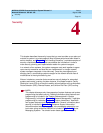
MERLIN LEGEND Communications System Release 6.1
Network Reference
555-661-150
Issue 1
August 1998
Security
Page 4-6Facility Restriction Levels and Remote Access
4
■ Extensions. The factory-set FRL for extensions is 3. When an extension
user attempts to use ARS or make a UDP call on his or her local system,
the extension FRL is compared to the local ARS or UDP route FRL. In
order for the call to go through, the extension FRL must be equal to or
greater than the route FRL.
■ VMI Ports. The factory-set FRL for VMI ports is 0.
■ Remote Access Default Class-of-Restriction. The factory-set FRL for
Remote Access is 3. To allow routing of calls through a system in a
network, the local system manager assigns an FRL and other restrictions
to a class of trunks, using remote access programming. This operation is
described in the next topic.
Remote Access Default
Class-of-Restriction Settings 4
All remote access COR settings are applied in networked systems for the
following calls:
■ UDP and ARS calls that arrive on tandem trunks from another networked
system and are routed to another system or to the PSTN.
■ Remote access calls that arrive at a local system on a public-switched
network DID trunk or PRI dial-plan routed facility.
■ Remote access calls that are made by entering a Remote Access code that
has been included in the non-local dial plan of the calling system.
■ In Release 6.1 and later systems, calls that arrive on lines assigned to a
calling group with a non-local member that are routed to a remote system.
The Remote Access COR settings must be planned and implemented carefully to
permit ARS and UDP extension calls across the network as appropriate, while
prohibiting remote access calling that might violate an organization’s security
needs.
NOTE:
When remote access is explicitly assigned to a loop-start or ground-start
trunk or to a PRI facility routed by line appearance, that line/trunk is
assigned to remote access, and default COR settings do not apply if barrier
codes are required. The remote access user calls into the system on this
type of facility and enters the barrier code, if required, just as they do in
non-networked systems. The
Feature Reference
describes this operation.
SECURITYlALERT:
!
If barrier codes are not required, these calls receive default COR for non-tie
trunks. If the system uses tandem PRI trunks for ARS to route calls through
the system, then the calling restriction option of the default COR must be set
to unrestricted. This can lead to toll fraud.


















